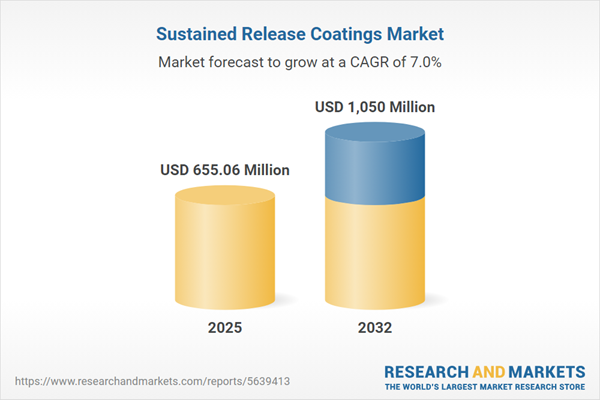Speak directly to the analyst to clarify any post sales queries you may have.
The sustained release coatings market is rapidly evolving, driven by advancements in pharmaceutical and nutraceutical delivery systems. Senior decision-makers require a clear understanding of competitive shifts, technology adoption, and changing procurement strategies shaping this sector’s future.
Market Snapshot: Growth Dynamics and Competitive Outlook
The Sustained Release Coatings market grew from USD 611.71 million in 2024 to USD 655.06 million in 2025, signaling positive momentum. Projected to continue expanding at a CAGR of 7.00%, the market is expected to reach USD 1.05 billion by 2032. This growth is attributed to rising demand for tailored drug delivery systems, regulatory movement toward patient-centric solutions, and greater investment in manufacturing efficiency and supply chain resilience.
Scope & Segmentation: Geographies, Technologies, and Applications
Our analysis provides full-spectrum market segmentation, enabling agile business decision-making:
- Release Duration: Long acting, medium acting, and short acting formulations for flexible therapeutic regimens.
- Product Form: Capsules, coated particles, pellets, and tablets—each supporting specific release profiles and scalability requirements.
- Polymer Type: Ethyl cellulose, hydroxypropyl methylcellulose (HPMC), methacrylate copolymers, and polyvinyl alcohol (PVA) for selective drug release and process optimization.
- Mechanism: Diffusion-controlled, erosion-controlled, and osmotic-controlled release systems supporting diverse therapeutic and performance needs.
- End Use: Nutraceutical companies focused on simplicity and cost, alongside pharmaceutical providers prioritizing compliance and advanced bioavailability.
- Regional Coverage: Americas, Europe, Middle East & Africa, and Asia-Pacific. Market-specific trends are reviewed for United States, Canada, Mexico, Brazil, Argentina, Chile, Colombia, Peru, United Kingdom, Germany, France, Russia, Italy, Spain, Netherlands, Sweden, Poland, Switzerland, United Arab Emirates, Saudi Arabia, Qatar, Turkey, Israel, South Africa, Nigeria, Egypt, Kenya, China, India, Japan, Australia, South Korea, Indonesia, Thailand, Malaysia, Singapore, and Taiwan.
- Leading Companies Profiled: Colorcon, Inc., Evonik Industries AG, Ashland Global Holdings Inc., Shin-Etsu Chemical Co., Ltd., Roquette Frères SA, BASF SE, DuPont de Nemours, Inc., Dow Inc., The Lubrizol Corporation, Lonza Group AG.
Sustained Release Coatings: Key Takeaways for Decision-Makers
- Next-generation polymer technologies enable multifunctional coatings, merging therapeutic customization with cost reduction across product lifecycles.
- Automation, real-time monitoring, and process analytical technologies are raising output quality and yield, improving scalability and compliance for global manufacturers.
- Collaborations among raw material suppliers, equipment makers, and contract development organizations foster product innovation and regulatory readiness.
- Patent activity, R&D partnerships, and selective M&A moves are enabling industry leaders to secure end-to-end value chain integration.
- Sustainability initiatives such as solvent-free and water-based coatings are gaining traction, aligning with regional compliance trends and eco-conscious market preferences.
- Comprehensive segmentation—by product form, polymer type, and release mechanism—supports precise product positioning and market entry strategies tailored to region and end user.
Tariff Impact: United States Cost Shifts and Adaptive Strategies
The introduction of revised U.S. tariffs in 2025 triggered supply chain realignments across the sustained release coatings ecosystem. Notably, organizations responded by reengineering procurement models, intensifying R&D collaboration with domestic polymer producers, and prioritizing solvent-efficient and high-solids coating formulations to mitigate cost exposure. Nearshoring and dual sourcing emerged as key approaches in maintaining operational resilience, sharpening competitive positioning for both domestic and multinational players.
Research Methodology & Data Sources
This report’s market intelligence is built on primary interviews with industry experts, direct facility observations, and consultations across regulatory and manufacturing nodes. Secondary research incorporated peer-reviewed publications, patent filings, proprietary contract manufacturing activity databases, and sector-specific white papers. Statistical techniques including cross-sectional regression and scenario analysis underpin both trend forecasting and tariff impact assessment.
Why This Report Matters: Actionable Insights for B2B Leaders
- Gain data-driven insights to inform product development, procurement, and expansion initiatives in the sustained release coatings sector.
- Understand regional dynamics, segment relevance, and the impact of regulatory innovation to align business strategy with shifting market demand.
- Benchmark against industry leaders and identify partnership opportunities across the value chain.
Conclusion
Strategic investment in advanced polymer technology, automation, and collaborative innovation is central to maintaining competitiveness in the sustained release coatings market. Segmentation intelligence and adaptability to supply chain shifts will guide successful growth and operational efficiency for leaders in this evolving sector.
Additional Product Information:
- Purchase of this report includes 1 year online access with quarterly updates.
- This report can be updated on request. Please contact our Customer Experience team using the Ask a Question widget on our website.
Table of Contents
3. Executive Summary
4. Market Overview
7. Cumulative Impact of Artificial Intelligence 2025
List of Figures
Samples

LOADING...
Companies Mentioned
The key companies profiled in this Sustained Release Coatings market report include:- Colorcon, Inc.
- Evonik Industries AG
- Ashland Global Holdings Inc.
- Shin-Etsu Chemical Co., Ltd.
- Roquette Frères SA
- BASF SE
- DuPont de Nemours, Inc.
- Dow Inc.
- The Lubrizol Corporation
- Lonza Group AG
Table Information
| Report Attribute | Details |
|---|---|
| No. of Pages | 187 |
| Published | October 2025 |
| Forecast Period | 2025 - 2032 |
| Estimated Market Value ( USD | $ 655.06 Million |
| Forecasted Market Value ( USD | $ 1050 Million |
| Compound Annual Growth Rate | 7.0% |
| Regions Covered | Global |
| No. of Companies Mentioned | 11 |









